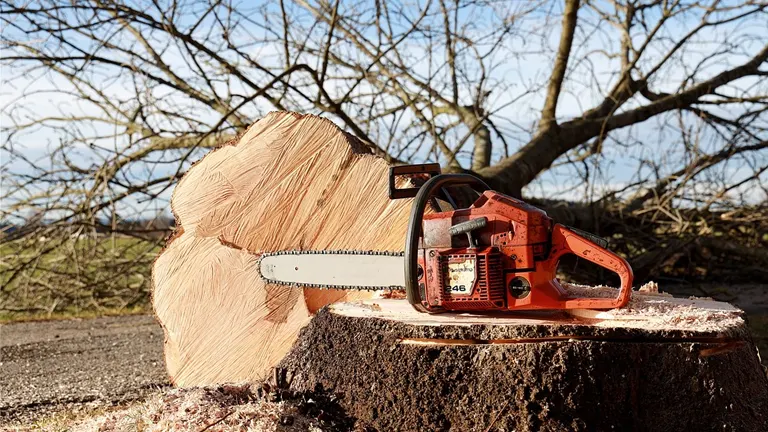10 Essential Chainsaw Tips for Mastering Your Chainsaw: From Safety to Precision
- February 7, 2025
- 0 comment

Chainsaws are incredibly powerful tools that can make quick work of cutting trees, chopping firewood, and handling various types of woodwork projects. However, this power also means a high potential for danger if not used correctly.
Mastering your chainsaw not only enhances your efficiency but also ensures your safety. This article covers 10 essential chainsaw tips for becoming proficient with your chainsaw, from safety measures to precision techniques.
Tip 1: Prioritize Safety
Safety should always come first before starting your chainsaw. Always wear protective gear, including a helmet, goggles, gloves, ear protection, and steel-toed boots. These items can help protect you from flying debris and loud noises.
Make sure the area around you is clear of obstacles and people to avoid accidents. Before you begin cutting, check your chainsaw for any damage or issues that could cause problems while you work. This includes inspecting the chain, bar, and safety features. Remember, just a moment of carelessness can lead to serious injuries, so take the time to prepare properly.
Tip 2: Choose the Right Chainsaw
Not all chainsaws are the same. There are gas-powered, electric, and battery-powered models, each with its own pros and cons. Think about what you need whether it’s for heavy logging, occasional yard work, or something else to pick the right chainsaw.
Selecting the right tool will make your tasks easier and safer. Consider factors like power, weight, and comfort, as these can affect how easy it is to use the chainsaw. A heavier chainsaw might be hard to use for long periods, while a lighter one could be better for more precise tasks. Choosing the right chainsaw will help you work more efficiently and comfortably.
Tip 3: Learn Proper Handling Techniques
Knowing how to handle and start your chainsaw is very important. Use the right grip both hands should be on the chainsaw at all times, with your left hand on the handle and your right hand on the trigger. This grip gives you better control and reduces the risk of accidents while cutting.
Stand firmly and balanced to control the chainsaw well. Always cut at waist height or lower to keep control. Practicing these techniques will help you work more efficiently and significantly reduce the chance of accidents. Keeping your body to the side of the saw will also help protect you from kickback injuries.
Tip 4: Regular Maintenance is Key
To keep your chainsaw working well, regular maintenance is necessary. Clean the chainsaw after each use, making sure the chain and bar are free of dirt and debris. This simple step helps your chainsaw perform better and last longer.
Lubricate the chain regularly to keep it running smoothly. Sharpen the chain and check its tension often; a dull or loose chain can lead to accidents. Taking care of your chainsaw will help it last longer, making it a reliable tool for years to come. Always check your owner’s manual for specific maintenance tips for your model.
Tip 5: Mastering the Art of Cutting
There are various types of cuts you can perform with a chainsaw, such as bucking, felling, limbing, and pruning. Each requires specific techniques:
- Bucking: Cutting a log into lengths
- Felling: Cutting down a tree
- Limbing: Removing branches from a felled tree
- Pruning: Trimming limbs off a standing tree
Avoid common mistakes like cutting too deep or allowing the chainsaw to kick back. Always cut from the top down and be mindful of the chain’s reactive forces. Practice these techniques to improve your precision and effectiveness.
Tip 6: Efficient Fuel Usage
Using good quality fuel and oil is important for your chainsaw’s health. Ethanol-free gasoline is often recommended for better performance. When refueling, turn off the chainsaw and let it cool down first to prevent accidents and spills.
Store your fuel in a cool, dry place away from sunlight. Using fuel efficiently will improve performance and reduce wear on the engine. Always follow the manufacturer’s instructions for the right fuel-to-oil mixture for your chainsaw to keep it running smoothly.
Tip 7: Stay Aware of Your Surroundings
Be aware of your environment while using a chainsaw. Look for potential hazards like overhead branches or hidden objects in the cutting area. This awareness can help you avoid accidents and make your work safer.
Make sure that people and pets are at a safe distance to prevent injuries. Before starting any cutting task, check the area for stability and ensure you have a clear escape route in case of an emergency. Staying alert will help you work more safely and effectively.
Tip 8: Know When to Seek Professional Help
Some tasks may be too big or dangerous to handle alone. Recognize when you need professional help, such as for cutting down large trees or working near power lines. Hiring experts can keep you safe and ensure the job is done correctly.
Don’t hesitate to call in professionals when faced with particularly challenging or hazardous situations. It’s better to be safe than to risk injury or damage to property. Knowing your limits is an important part of using a chainsaw responsibly.
Tip 9: Practice Makes Perfect
Like any skill, using a chainsaw well takes practice. Start with smaller tasks to build your confidence and skills. As you get better, gradually take on bigger projects to challenge yourself and improve your abilities.
Joining a community or taking classes can provide valuable tips and hands-on experience. Learning from others can help you gain new skills and insights, making you a more confident and capable chainsaw user.
Tip 10: Keep Updated with the Latest Techniques and Tools
The world of chainsaws is always changing with new models, accessories, and techniques. Stay informed by reading articles, watching videos, and attending workshops. This knowledge can help you stay safe and improve your cutting skills.
Learning from experienced users can give you advanced tips that will help you master your chainsaw. Keeping up with the latest developments will ensure you’re using the best practices and tools available.
Conclusion
Mastering the use of a chainsaw goes beyond just cutting wood it’s about prioritizing safety, understanding the proper handling techniques, and maintaining your equipment to ensure peak performance. By following these 10 essential chainsaw tips, you’ll enhance your efficiency, prolong the lifespan of your chainsaw, and most importantly, stay safe.
Whether you’re cutting down trees, bucking logs, or simply trimming branches, developing your skills and staying informed on the latest techniques and tools will keep you at the top of your game. Remember, practice makes perfect, but safety and proper technique should always be your top priorities.
Frequently Asked Questions
1. What protective gear should I wear when using a chainsaw?
Always wear a helmet, goggles, gloves, ear protection, and steel-toed boots to protect yourself from flying debris, loud noises, and potential injuries.
2. How do I choose the right chainsaw for my needs?
Consider the type of work you’ll be doing. For heavy-duty tasks, a gas-powered chainsaw might be best, while electric or battery-powered models are ideal for lighter jobs and ease of use.
3. What’s the proper way to handle a chainsaw?
Always use both hands with a firm grip, keep your body balanced, and cut at waist height or lower. This helps you maintain control and reduces the risk of accidents.
4. How often should I maintain my chainsaw?
After each use, clean the chainsaw, check for any damage, and ensure the chain and bar are free of dirt. Regularly lubricate, sharpen the chain, and check its tension for optimal performance.
5. What are the different types of chainsaw cuts?
Bucking is cutting logs into sections, felling is cutting down a tree, limbing is removing branches, and pruning is trimming standing trees. Each requires specific techniques.
6. How can I use fuel efficiently for my chainsaw?
Use ethanol-free gasoline and always follow the manufacturer’s recommendations for fuel and oil mixtures—store fuel in a cool, dry place to maintain its quality.
7. How do I stay safe while using a chainsaw?
Be aware of your surroundings, check for overhead hazards, and ensure people and pets are at a safe distance. Always plan an escape route before starting a cutting task.
8. When should I call in a professional instead of doing it myself?
For large, dangerous tasks such as cutting down big trees or working near power lines, it’s best to hire a professional to ensure safety and avoid accidents.
9. How can I improve my chainsaw skills?
Start with smaller tasks to build confidence and gradually work your way up to larger projects. Joining a community or taking chainsaw classes can also be helpful.
10. What are some ways to stay updated with chainsaw techniques and tools?
Read articles, watch videos, and attend workshops to learn about the latest chainsaw models, accessories, and cutting techniques. Staying informed ensures you’re always using the best practices.
We hope these 10 essential tips for mastering your chainsaw have provided you with valuable insights into safe and efficient chainsaw operation. Whether you’re a beginner or an experienced user, applying these tips can help you improve your cutting skills, maintain your equipment, and complete your projects with confidence and precision.
If you have any additional tips or experiences with chainsaws, we encourage you to share them in the comments below. Your advice can help others navigate their chainsaw journeys with greater ease. Don’t forget to share this article with anyone who might find it helpful. With the right knowledge and technique, you’ll be well-equipped to take on any woodcutting task.

David Murray
Forestry AuthorI'm David Murry, a forestry equipment specialist with a focus on chainsaw operation. With over 13 years of experience, I've honed my skills in operating and maintaining a wide range of machinery, from chainsaws to log splitters. My passion for the outdoors and commitment to sustainable forestry drive my work, which emphasizes safety, efficiency, and staying updated with industry advancements. Additionally, I'm dedicated to sharing my expertise and promoting environmental awareness within the forestry community.













Leave your comment